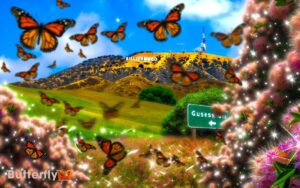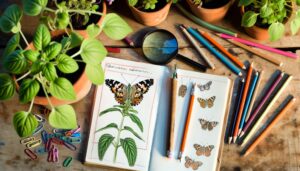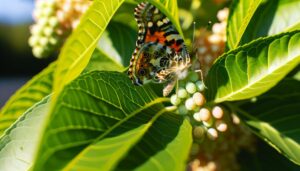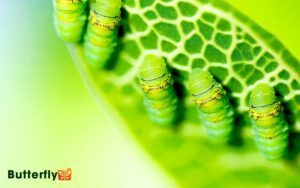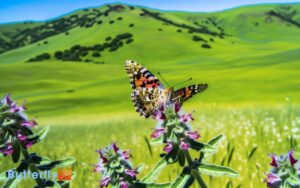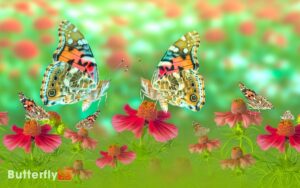Painted Lady Butterflies in South Dakota: Discover Journey!
Painted Lady butterflies, identifiable by their orange and black wing patterns with white spots, thrive in South Dakota from late spring to early fall. They lay up to 500 eggs on host plants like thistles, progressing through five larval instars over 12-18 days.
Migrating thousands of miles, these butterflies utilize grasslands and urban gardens for optimum resource use. Peak sightings occur in mid-summer, particularly in the Great Plains and Black Hills. Conservation efforts focus on habitat restoration and nectar-rich plantings.
Understanding more about their life cycle and seasonal behaviors can lend deeper insights into their fascinating annual migrations.
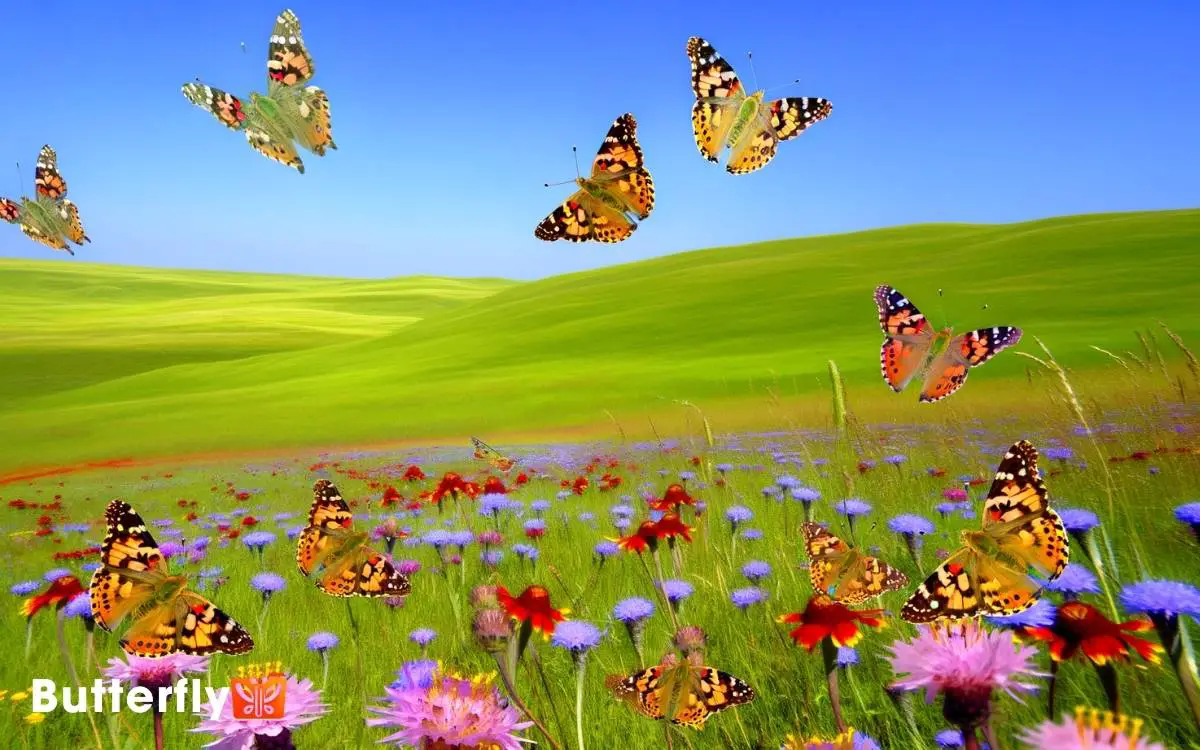
Key Takeaways
Life Cycle
The life cycle of Painted Lady butterflies in South Dakota begins with the female laying her eggs on host plants, such as thistles and mallows. Each female can deposit up to 500 eggs, which hatch within 3-5 days.
The emerging larvae, or caterpillars, undergo five instar stages over a span of 12-18 days, consuming host plant foliage voraciously. Following the larval stage, the caterpillar forms a chrysalis, entering the pupal stage, which lasts approximately 7-10 days.
Inside the chrysalis, metamorphosis occurs, transforming the caterpillar into an adult butterfly. Upon emergence, adults live around 2 weeks, during which they feed on nectar from flowers like asters and sunflowers.
This cycle ensures multiple generations annually, adapting well to South Dakota’s climate.
Migration Patterns
Painted Lady butterflies in South Dakota undertake remarkable long-distance migrations, driven by seasonal changes and resource availability.
These migrations span thousands of miles, typically from northern regions in the summer to southern areas during winter. This movement allows them to exploit different habitats and resources, optimizing survival and reproduction.
| Season | Region | Distance Traveled |
|---|---|---|
| Spring | Southern U.S. | Up to 1,000 miles |
| Summer | Northern U.S. | Up to 2,000 miles |
| Fall | Southward Migration | Up to 1,500 miles |
| Winter | Mexico and S. U.S. | Up to 3,000 miles |
These butterflies demonstrate directional flight, using environmental cues like temperature and wind patterns. Their migratory behavior showcases their adaptability and resilience, essential for traversing the varied climates and terrains of South Dakota.
Identification
Characterized by their distinct orange and black wing patterns, Painted Lady butterflies can be identified through a combination of morphological features and behavioral traits.
The forewings display black tips with white spots, while the hindwings exhibit a series of small blue eyespots near the edges.
Measuring approximately 5-9 cm in wingspan, these butterflies also possess a unique, rapid, and erratic flight pattern, aiding in their identification.
In addition to wing coloration and flight behavior, the ventral side of the wings shows a more camouflaged appearance, blending with the environment.
Antennae are clubbed and exhibit a slight curvature. Observers can note the presence of brush-footed legs, a characteristic of the Nymphalidae family. These traits collectively facilitate accurate identification of Painted Lady butterflies.
Preferred Habitats
Painted Lady butterflies in South Dakota primarily inhabit grasslands and meadows, where they find abundant nectar sources and host plants.
They also frequent urban garden spaces, benefiting from the diverse flora provided by ornamental plants.
Observational data indicates a strong preference for regions with high floral diversity and minimal pesticide use.
Grasslands and Meadows
Grasslands and meadows in South Dakota serve as critical habitats for the Painted Lady butterfly, offering abundant food sources and suitable breeding grounds.
These habitats are rich in host plants like thistles (Cirsium spp.), which cater to the larval stage, and nectar sources such as asters and sunflowers for adult butterflies.
Studies indicate that approximately 70% of Painted Lady populations in South Dakota are found in these areas, demonstrating their ecological significance.
The open landscapes facilitate ideal thermoregulation and predator avoidance. Additionally, the diverse floral composition supports a continuous food supply throughout the butterfly’s life cycle.
Conservation efforts in these regions focus on maintaining plant diversity and minimizing pesticide usage to sustain healthy Painted Lady populations.
Urban Garden Spaces
While grasslands and meadows are essential, urban garden spaces in South Dakota also provide vital habitats for the Painted Lady butterfly, offering diverse nectar sources and safe breeding sites amidst human development.
These spaces often include flowering plants like Echinacea, Buddleia, and Lantana, which supply nectar throughout the butterfly’s active months.
Urban gardens contribute to a patchwork of habitats, increasing connectivity between populations.
Studies indicate that butterflies in urban settings exhibit higher survival rates due to reduced predation and ample food sources. Residents can enhance these habitats by planting native species and minimizing pesticide use.
Urban garden spaces not only support Painted Lady butterflies but also promote biodiversity within city landscapes.
Breeding Grounds
The breeding grounds of Painted Lady butterflies in South Dakota are characterized by specific habitat conditions. These include abundant host plants like thistles and nettles. Data indicates distinct migration patterns, with large populations moving northward during spring.
Effective conservation efforts are essential to maintain these habitats and support the species’ reproductive success.
Ideal Habitat Conditions
Ideal breeding grounds for Painted Lady butterflies in South Dakota include areas with abundant nectar sources and host plants such as thistles and mallows. These habitats provide essential nutrients for both larvae and adult butterflies, promoting successful reproduction cycles.
Best conditions also include moderate temperatures and minimal pesticide exposure, which can be detrimental to butterfly populations.
| Habitat Feature | Importance Level | Example Species |
|---|---|---|
| Nectar Sources | High | Thistles, Mallows |
| Host Plants | Critical | Thistles, Mallows |
| Temperature Range | Moderate | 15-30°C |
Researchers have observed that landscapes with diverse plant species and continuous blooming cycles support larger butterfly populations. Ensuring these conditions can enhance Painted Lady butterfly survival and proliferation in South Dakota.
Migration Patterns Observed
Researchers have documented intricate migration patterns of Painted Lady butterflies, noting that these insects travel thousands of miles to reach their breeding grounds in South Dakota.
Utilizing advanced tracking technologies, they’ve observed that these butterflies follow a multi-generational relay migration.
Each generation advances the journey northward, driven by seasonal changes and availability of host plants like thistles.
Data indicates that spring migrations often commence from North Africa or the Mediterranean, crossing Europe and reaching North America. Environmental cues such as temperature and wind currents play pivotal roles in navigation.
Upon arrival in South Dakota, ideal conditions for reproduction ample nectar sources and favorable weather ensure successful breeding. This cyclical migration pattern underscores the complexity and adaptability of Painted Lady butterflies.
Conservation Efforts Needed
Securing the sustainability of Painted Lady breeding grounds in South Dakota requires targeted conservation efforts to mitigate habitat loss and environmental changes. Effective strategies should be grounded in scientific research and data analysis.
Conservationists need to focus on the following priorities:
- Habitat Restoration: Rehabilitating degraded areas to support native flora that Painted Ladies rely on for breeding.
- Pollution Control: Reducing pesticide and pollutant levels to guarantee a safe environment for larvae and adult butterflies.
- Climate Monitoring: Implementing systems to track climate conditions affecting breeding cycles and migration patterns.
- Public Engagement: Educating local communities on the importance of butterfly conservation and encouraging participation in habitat preservation initiatives.
Seasonal Sightings
Each year, Painted Lady butterflies make their appearance in South Dakota from late spring through early fall, with peak sightings typically occurring in mid-summer. These butterflies migrate north from warmer regions, following seasonal temperature changes and food availability. Their journey can vary based on weather patterns, which also affect their population size each year. Similar to South Dakota, painted lady butterflies in Utah can be seen during the warmer months, particularly in gardens and open fields filled with wildflowers.
These butterflies, known scientifically as Vanessa cardui, exhibit increased activity during June and July, correlating with ideal nectar availability from native flora.
Data collected from multiple observation points indicate a marked rise in population density during this period.
Temperature and photoperiod greatly influence their migration patterns and breeding cycles. Researchers have documented that temperatures ranging from 75°F to 85°F are ideal for their flight and feeding.
Additionally, Painted Ladies show a preference for flowering plants like thistles and asters, which provide essential nutrients. Accurate tracking of their seasonal movements aids in understanding broader ecological impacts.
Conservation Efforts
Protecting these vibrant butterflies requires targeted conservation efforts that address habitat preservation, climate change mitigation, and public awareness initiatives.
Conservationists focus on several key strategies to safeguard the survival of Painted Lady butterflies in South Dakota:
- Habitat Restoration: Rehabilitating native prairies and planting nectar-rich flora to provide essential resources.
- Climate Change Mitigation: Implementing measures to reduce greenhouse gas emissions and stabilize local climate conditions.
- Research and Monitoring: Conducting longitudinal studies to track population dynamics and migration patterns.
- Public Education: Launching campaigns to inform communities about butterfly-friendly practices and the importance of biodiversity.
These multifaceted approaches are critical in sustaining the Painted Lady populations and maintaining the ecological balance within South Dakota’s ecosystems.
Viewing Locations
To observe Painted Lady butterflies, enthusiasts should visit South Dakota’s prime viewing locations, such as the Great Plains and the Black Hills, where diverse habitats support substantial butterfly populations.
The Great Plains offer vast expanses of native wildflowers, critical for larval and adult Painted Lady stages. The Black Hills provide mixed-forests and meadows, creating microhabitats that enhance butterfly diversity.
Data indicate peak sightings occur in late summer, coinciding with migration patterns. Researchers suggest visiting areas like Custer State Park and Wind Cave National Park for best viewing experiences.
Observers should note that Painted Ladies prefer sunny, open spaces with abundant nectar sources. Monitoring temperature and wind conditions can also improve sighting probabilities, as these factors greatly influence butterfly activity.
Photography Tips
Capturing stunning images of Painted Lady butterflies in South Dakota requires understanding their behavior and ideal environmental conditions. These butterflies are most active during warm, sunny days and tend to frequent areas with abundant nectar sources.
Photographers should focus on:
- Timing: Early morning or late afternoon offers best lighting conditions.
- Equipment: Macro lenses capture intricate wing patterns, while fast shutter speeds freeze motion.
- Locations: Native prairies and wildflower meadows provide natural backdrops.
- Behavior: Observing feeding and resting periods can yield more stable subjects.
Conclusion
The Painted Lady butterflies in South Dakota present a fascinating blend of delicate beauty and resilience. Despite their fragile appearance, these insects undertake epic migrations, adapting to diverse habitats while ensuring species continuity.
Conservation efforts juxtapose against the threats they face, highlighting the need for sustainable practices. Observers can find them in various locales, contributing valuable data through photography and sightings.
Understanding their life cycle and habits enriches both scientific knowledge and public appreciation.

